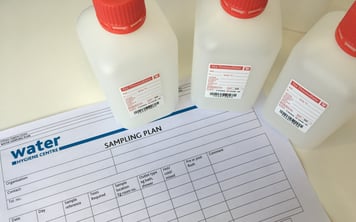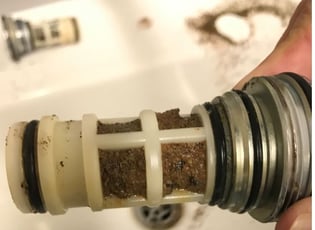As discussed in Part 1, temperature has limited effectiveness when treating biofilm bacteria (especially mature biofilm) but colonisation of a system with biofilm bacteria may (in the main) be avoided should water temperature be kept within specification and the water within the system is in regular movement/turned over.
Why are my water samples testing positive for Legionella?
When outlets test positive for bacteria of ‘human importance’, it’s firstly important to question ‘why’ and to ascertain to what extent the water system has been compromised (i.e., how big is the loss of control…?).
With this in mind, it’s often prudent to establish ‘if’ contaminated outlets have been in regular use or included in a Legionella flushing regime – as necessary, as it’s commonplace for infrequently used and/or poorly maintained outlets to test positive for waterborne bacteria.
 Therefore, not all water sample results testing positive for the ‘target organism’ substantiate the use of disinfection methods as a strategy of control before the following have been appraised:
Therefore, not all water sample results testing positive for the ‘target organism’ substantiate the use of disinfection methods as a strategy of control before the following have been appraised:
- The number of colony-forming units recovered (cfu/volume sample) in a particular sample;
- Pre and post-flush test results;
- The number of outlets affected;
- Adherence to established legionella flushing regimes – in accordance with the organisational Water Safety Plan/Written Scheme;
- Adherence to established cleaning practices – following the organisational written scheme (water safety plan);
- Adherence to the monitoring of water systems through pre-planned maintenance (PPM’s);
- Outstanding recommendations and priority actions detailed in the site-specific risk minimisation scheme;
- Remedial activity both within or outside the affected premises – whereby remediation works outside of the affected premises may have impacted upon water quality at the point of entry to a building (water undertaker works, fire service etc)
Whilst the above list is by no means exhaustive, it encourages the identification of the root cause of the problem favouring a more targeted rather than indiscriminate approach to applying a routine disinfection strategy.
If we consider the properties of an ‘ideal disinfectant’ such as:
- Long lasting residual;
- Not impacted by pH, temperature or organic contaminants and corrosion or scale;
- No health and safety considerations for use;
- Broad spectrum effectiveness (effective against a wide range of bacterial contaminants);
- Cost effective;
- Non-corrosive/damaging to water systems – including aesthetics as well as integrity of water systems;
- Environment-friendly – including waste production.
What are my options for controlling Legionella and other waterborne bacteria?
We can quite quickly arrive at the conclusion that sadly there is no such thing as an ideal disinfectant, however, by identifying and understanding causal issues with our water systems and taking a system-specific approach to water quality we will be improving our chances of an ‘ideal outcome’ (i.e. removing waterborne bacteria from our water systems or at least controlling them within safe limits).
Various chemical methods of disinfection can offer a solution/support with the periodic cleaning of water storage vessels through to the commissioning of new water systems whereby disinfection forms part of the commissioning process.
Chlorine Dioxide can be indicated specifically for the removal of biofilm from water systems where the use of Chlorine would be comparatively less effective and both oxidising biocides may be indicated for the treatment of water systems on a permanent basis whereby concerns exist surrounding the effectiveness of the control scheme.
In such situations be mindful of the dosing residual to ensure that water remains within drinking water specification (fluid category 1). If for example system-contamination with mature biofilm is suspected then the use of chemistries such as chlorine dioxide may be indicated at a higher dose – resulting in the system being taken offline until all chemicals have been safely flushed through the system.
Whilst the effectiveness of such chemistries as ‘biofilm removers’ has been well-documented, the oxidising nature of these chemicals may inevitably impact upon the integrity and subsequent lifespan of water systems – if relied upon as a mainstay control strategy. Therefore, caution should be exercised in this regard, and focus placed on using the traditional method of control – where reasonable and practicable to do so.
Another recognised control strategy being copper-silver (Cu-Ag) ionisation has demonstrated good effectiveness against Legionella bacteria but are not without limitation as the broad-spectrum effectiveness of this strategy is not well known.
Whilst it offers advantages over oxidising biocides by not impacting the integrity of the water system, silver (Ag) ions have been demonstrated to stain sanitary ware and the adequate management of these systems requires maintenance resources to; maintain the efficacy of electrodes (especially in hard water areas – whereby water softeners are required and associated maintenance) and completion of required chemistry tests to ensure the desired concentration of Cu-Ag throughout the treated system.
Finally, point of use (POU) water filters may provide a ‘physical barrier whereby the primary concern is protecting patients from waterborne pathogens at the point of use.
Whilst these filters may remove the requirement to; isolate outlets from clinical use and or move patients to unaffected hospital areas (whilst required remedial works are undertaken), such filters may slow the water flow to the outlet which may in turn increase the risk of bacterial contamination behind the filter and local to the outlet.
The Responsible Person [Water]/Authorised Person [Water] needs to be aware of the condition of the water systems which they are responsible for.
Where a temperature strategy has been shown not to be effective in maintaining control, alternative control strategies should be considered (long-term/short-term application).
Whilst no disinfection regimen is without flaws, a combination of disinfection regimens may offer the most robust results following an adequate appraisal of the water system to be treated.
Check out our FAQ page around Legionella, water hygiene, and waterborne pathogens
Feel free to reach out if you have any questions about the issues mentioned above or if you would like to consult with one of our experts on water hygiene.
Editors Note: The information provided in this blog is correct at date of original publication - August 2018. (Revised July 2024)
© Water Hygiene Centre 2024




![POUF [point of use water filter]](https://www.waterhygienecentre.com/hs-fs/hubfs/POUF%20%5Bpoint%20of%20use%20water%20filter%5D.jpg?width=301&name=POUF%20%5Bpoint%20of%20use%20water%20filter%5D.jpg)





